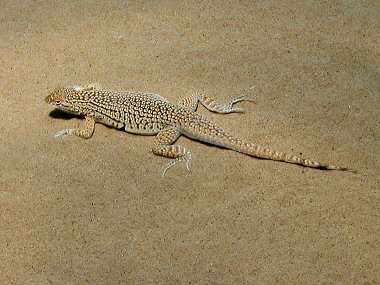| |
Fringe-Toed Lizard
 |
 |
 |
|
|
| Fringe-Toed Lizards are adapted for life
in the sandy desert. In addition to their brown and tan coloration which
helps them to blend in with the sand, they have special scales which
form a fringe on the sides of their toes which aid in traction, speed
and keep the lizard from sinking on loose sandy dunes. In addition they
also possess an upper jaw which overlaps the lower, preventing the
intrusion of sand particles, nostrils that can be closed at will, flaps
that close against the ear openings when moving through sand and
interlocking scales on the upper and lower eyelids, which prevent sand
from getting into the eyes. . |
| |
 |
Natural
History |
 |
|
The Fringe-Toed Lizards range
 covers
southeast California and southwest Arizona, and extends into northwest
Sonora and northeast Baja California in low desert areas having fine,
loose sand. The lizards primarily eat insects, including ants, beetles,
grasshoppers, and caterpillars. Flower buds, stems, leaves and seeds of
plants are also eaten. covers
southeast California and southwest Arizona, and extends into northwest
Sonora and northeast Baja California in low desert areas having fine,
loose sand. The lizards primarily eat insects, including ants, beetles,
grasshoppers, and caterpillars. Flower buds, stems, leaves and seeds of
plants are also eaten.
|
The Fringe-Toed Lizard will dive
under the sand, burying itself, to avoid predators or extreme
heat. |
Every 4-6 weeks throughout the summer, females will
lay a clutch of 1-5 eggs (average 2). In 1980 this lizard was listed as
a threatened species by the federal government. |
Back to Flora & Fauna |
|

